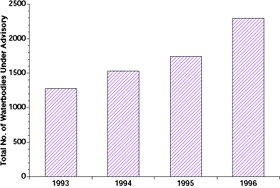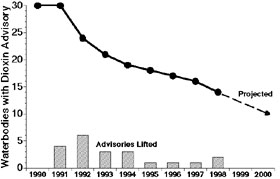Liftings of Fish Consumption Advisories for
Dioxin Downstream of U.S. Pulp Mills
The Alliance for Environmental Technology
1998 UPDATE
![]()
Table of Contents
- Executive Summary
- Fish Advisories Summary
- State Fish Consumption Advisories
- Dioxin Advisories
- Industry and Eco-system Responses
- Dioxin Advisory Liftings
- Future Prospects
- References
- Appendices
Download the entire report as a PDF file. If you don't have the Acrobat Reader click here to download and install on your computer.
Executive Summary
On April 15, 1998, the United States Evironmental Protection Agency (EPA) announced its conclusion regarding the technology basis for Best Available Technology (BAT) options as part of its pulp and paper Cluster Rule. The Cluster Rule sets effluent limitations and pretreatment guidelines for all bleached pulp, paper, and paperboard mills. According to EPA, the Cluster Rule will virtually eliminate dioxin discharges and as a direct result will eliminate, over time, all remaining dioxin-based fish advisories that have been attributed to pulp and paper mills. EPA Administrator Carol M. Browner stated [1]:
"Today we are taking significant steps to protect the health of millions of American families from contaminated air and water from pulp and paper mills. This action puts us well on our way to cleaning up more than 70 rivers and streams throughout the nation."
EPA chose to base its Cluster Rule guidelines on a technology option which includes the complete (100 percent) substitution of chlorine dioxide for chlorine - so called Elemental Chlorine-Free (ECF). While the Cluster Rule seeks elimination of dioxin, the U.S. industry is far ahead of the rule in achieving this goal.
As a result of the increased use of chlorine dioxide, ECF, and the other technical and process changes adopted by the industry, dioxin discharges have been virtually eliminated. According to the American Forest & Paper Association (AF&PA), all but one of the U.S. mills are at or below a dioxin final effluent concentration of 10 parts per quadrillion, the nominal "minimum level" that can be measured.
The eco-system is reaping the benefit of this successful strategy, while the total number of waterbodies under some type of advisory is rising in the U.S.,the number of waterbodies under a dioxin advisory downstream of bleached chemical pulp mills is falling. In fact such advisories are a very small and diminishing percentage of the overall total of affected waterbodies in the country. In 1998, two more advisories were lifted, continuing a trend established in the early nineties and in line with EPA's projections. See Figure 1 below:
Figure 1:
While Overall Fish Consumption Advisories Are Rising,
Dioxin Advisories Downstream Of Pulp Mills Are Falling

|
 |
Fish Advisories Summary
Fish advisories are an issue of concern for both anglers and those government agencies charged with safeguarding public health. In response to this concern, the Alliance for Environmental Technology (AET) annually conducts an analysis of EPA and state environmental and health authority data for fish consumption advisories.
The analysis reveals three important findings regarding fish consumption advisories for dioxin.
1. First, according to the AET analysis, the total number of waterbodies, such as lakes, rivers, or bays, under a dioxin advisory represents just three percent of the total number of affected waterbodies in the U.S. According to EPA's 1997 National Listing of Fish and Wildlife Consumption Advisories (NLFWCA), there are currently 2,299 waterbodies under some type of advisory restricting fish or shellfish consumption (See Figure 2). Of this total, 65 waterbodies are under a consumption advisory for dioxin.
2. Second, for waterbodies downstream of U.S. bleached chemical pulp mills, dioxin advisories are rarer still. There are only 14 advisories downstream of bleached chemical pulp mills, amounting to less than one percent of the 2,299 water bodies under some type of advisory.
3. Third, the small number of waterbodies downstream of U.S. bleached chemical pulp mills that are under a dioxin advisory is steadily diminishing. Since 1990, 13 states have cleared, i.e., lifted, dioxin advisories from 21 waterbodies downstream of pulp mills, which is two-thirds of the 30 such advisories in effect in 1990. Two additional advisories were lifted in 1998.
Process changes in pulp production, including the increased use of chlorine dioxide as a bleaching agent, have virtually eliminated dioxin discharges and as a result markedly reduced tissue levels in fish living in mill receiving waters. In fact, dioxin levels in mill waste water are now non-measurable at all U.S. pulp mills, except one. State officials lift advisories once dioxin fish tissue levels drop and remain below state action levels.
In addition, the number of waterbodies downstream of pulp mills under a dioxin advisory is projected to continue downward. In an EPA study of current dioxin advisories, all such advisories will be lifted following implementation of the Agency's recently promulgated Cluster Rule, which has as part of its BAT, bleaching with chlorine dioxide.
State Fish Consumption Advisories
State environmental and health departments issue fish consumption advisories or bans to protect sport and subsistence anglers, and the general public, from the risk of consuming locally caught, contaminated fish.
Fish consumption advisories are based on the contamination levels of specific target chemicals, which include, among others, mercury, PCBs (polychlorinated biphenyls), and various pesticides. As such, these advisories are one indicator of the environmental status of a particular aquatic eco-system, for example a lake, bay, or river. Removing or partially rescinding a fish consumption advisory or ban generally signals positive change in the aquatic eco-system under study.
Since 1989, when the EPA completed the first national survey of state fish/shellfish advisory programs, the number of states reporting advisories has increased, as has the total number of advisories. In 1997, forty-seven states, the District of Columbia, and the Territory of American Somoa reported a total of 2,299 waterbodies under some type of advisory restricting fish/shellfish consumption, representing a 5 percent increase over 1996 data [2].
The 1997 EPA NLFWCA shows the total number of active advisories on which each target contaminant appears. As shown in Figure 3, mercury is listed on 1,782 advisories, PCBs on 588, DDT (and its degradation products, DDE and DDD) on 33, and dioxin on 65 advisories.
Dioxin Advisories
In 1998, only 14 waterbodies have a dioxin advisory downstream of bleached chemical pulp mills. These 14 affected waterbodies represent less than one percent of the total 2,299 U.S. waterbodies under some type of an advisory. Figure 4 shows the current number of waterbodies downstream of bleached chemical pulp mills that are under a dioxin advisory.
The EPA National Dioxin Study conducted in the mid-1980s provided one of the first indications that bleached kraft pulp mills were a possible source of dioxin. Following this study, and as a result of other work such as the "104 Mill Study" conducted jointly by EPA and the industry in 1988, scientists identified dioxin as an inadvertent by-product of the then prevailing pulp bleaching process [3].
Figure 5 shows the yearly number of waterbodies downstream of pulp mills placed under a dioxin advisory. The single largest yearly increase -- 17 waterbodies in 1990 -- was due to increased federal and state regulatory attention following the results of the national dioxin studies.
Industry and Eco-system Responses
In response to the discovery of dioxin as an inadvertent by-product of the then prevailing bleaching process at kraft mills, the pulp and paper industry introduced a number of technical changes and process modifications. These modifications included, among others, dioxin precursor-free defoamers, improved brown stock washing, and low multiple bleaching.
Key to the industry's dioxin reduction strategy has been the increased substitution of chlorine dioxide for chlorine gas as a bleaching agent [4]. As a result of the increased use of chlorine dioxide, and the other technical and process changes adopted by the industry, dioxin discharges have dropped considerably and have been virtually eliminated [5]. All but one of the U.S. mills are at or below a dioxin final effluent concentration of 10 parts per quadrillion, the nominal "minimum level" that can be measured, according to AF&PA. As a result of the process changes at bleached kraft mills 21 advisories have been lifted.
Dioxin Advisory Liftings
Since 1990, states have lifted a number of fish consumption advisories for dioxin demonstrating that current and declining levels of dioxin in receiving waters downstream of bleached chemical pulp mills are an insignificant risk to the aquatic eco-system. State environmental and health authority data show that since 1990, 13 states have lifted dioxin advisories on 21 waterbodies downstream of pulp mills.
As previously discussed, fish tissue levels of dioxin downstream of bleached chemical pulp mills have dropped significantly following process changes made since dioxin was first linked to pulp bleaching. In general, states lift advisories when the dioxin levels in tissue samples taken from fish species in the waterbodies of concern decline below the state's action level, and remain below this level during subsequent samplings.
Future Prospects
In April 1996, Maine's seven pulp mills, together with the Governor, announced a plan to eliminate within four years dioxin discharges from mills along the Kennebec, Androscoggin, and Penobscot rivers, demonstrating the industry's continued commitment to environmental protection [6]. Subsequently, the Governor's bill (L.D. 1633) formally requiring the industry to achieve such a goal, passed in the Maine legislature by an overwhelming majority [7]. The Maine Department of Environmental Protection recently reported that all mills are in compliance with the new regulation [8].
More recently, on April 15, 1998, EPA published a notice in the Federal Register announcing its conclusion regarding the technology basis for BAT options as part of its pulp and paper Cluster Rule. The Cluster Rule sets effluent limitations and pretreatment guidelines for all bleached pulp, paper, and paperboard mills. EPA chose to base its Cluster Rule guidelines on a technology option which includes the complete (100 percent) substitution of chlorine dioxide for chlorine [9].
Furthermore, EPA has stated that process changes, which are aimed to reduce the formation and discharge of dioxin in mill effluent to comply with guidelines, will provide for the potential lifting of fish advisories at sites downstream of pulp mills [10]. In an analysis of the remaining dioxin advisories, using the Dioxin Reassessment Evaluation model approach and the EPA's Best Available Technology option, the agency found that all remaining dioxin advisories downstream of pulp mills could be lifted once the guidelines are implemented [11]. Figure 6, consistent with EPA's projections, shows the declining number of waterbodies downstream of pulp mills under a dioxin advisory.
References
- EPA "EPA Eliminates Dioxin, Reduces Air and Water Pollutants from
Nation's Pulp and Paper Mills." Press release, Friday, November 14, 1997.
- EPA March 1998. Update: National Listing of Fish and Wildlife Consumption Advisories, Fact Sheet. U.S. Environmental Protection Agency, Office of Water. EPA-823-F-98-009.
- EPA. 1990. U.S. EPA/Paper Industry Cooperative Dioxin Study, "The 104 Mill Study": Statistical Findings and Analyses. U.S. Environmental Protection Agency, Office of Water Regulations and Standards.
- Luthe, C.E. et al. 1992. An Evaluation of the Effectiveness of Dioxin Control Strategies on Organochlorine Effluent Discharges from the Canadian Bleached Chemical Pulp Industry. Pulp and Paper Canada. 93:9.
- Solomon, K. et al. 1994. A Review and Assessment of the Ecological Risks Associated with the Use of Chlorine Dioxide for the Bleaching of Pulp. Submitted to the Journal of Pulp and Paper Science
- Boston Sunday Globe. "Maine Has Pact With Mills to Cut Dioxins in Rivers." April 21, 1996.
- Maine, "An Act to Make Fish in Maine Rivers Safe to Eat and Reduce Color Pollution."(1997), S.P. 528 - L.D.1633,
- "Maine Pulp & Paper Mills Are In Compliance With The Most Stringent Dioxin Law In The U.S," July 20, 1998. Press Release. Maine Pulp & Paper Association,
- EPA. July 1996. 61 Federal Register 36837. (7/15/96).
- EPA. December 1993. 58 Federal Register 66078, 66160. (12/17/93).
- EPA. November 1993. Regulatory Impact of Proposed Effluent Guidelines and NESHAP for the Pulp, Paper, and Paperboard Industry. U.S. Environmental Protection Agency, Office of Water Regulations and Standards.
Appendices